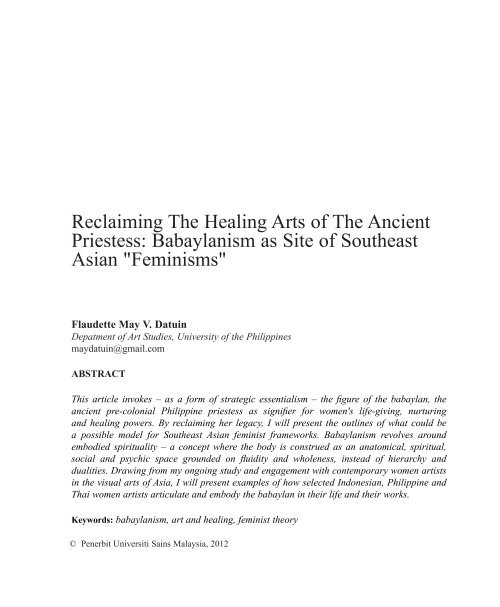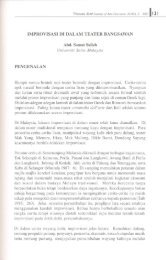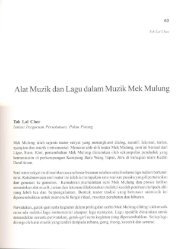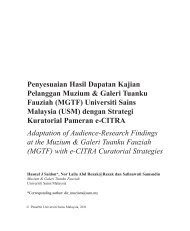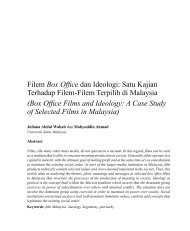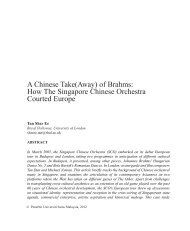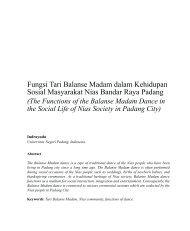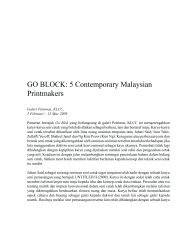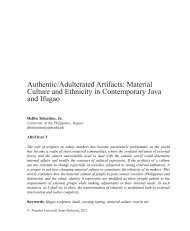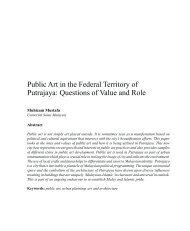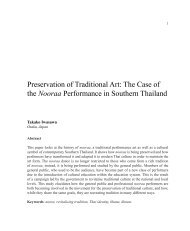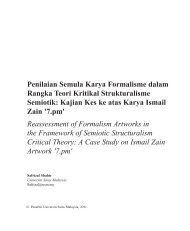Reclaiming The Healing Arts of The Ancient ... - Wacana Seni
Reclaiming The Healing Arts of The Ancient ... - Wacana Seni
Reclaiming The Healing Arts of The Ancient ... - Wacana Seni
You also want an ePaper? Increase the reach of your titles
YUMPU automatically turns print PDFs into web optimized ePapers that Google loves.
<strong>Reclaiming</strong> <strong>The</strong> <strong>Healing</strong> <strong>Arts</strong> <strong>of</strong> <strong>The</strong> <strong>Ancient</strong>Priestess: Babaylanism as Site <strong>of</strong> SoutheastAsian "Feminisms"Flaudette May V. DatuinDepatment <strong>of</strong> Art Studies, University <strong>of</strong> the Philippinesmaydatuin@gmail.comABSTRACTThis article invokes – as a form <strong>of</strong> strategic essentialism – the figure <strong>of</strong> the babaylan, theancient pre-colonial Philippine priestess as signifier for women's life-giving, nurturingand healing powers. By reclaiming her legacy, I will present the outlines <strong>of</strong> what could bea possible model for Southeast Asian feminist frameworks. Babaylanism revolves aroundembodied spirituality – a concept where the body is construed as an anatomical, spiritual,social and psychic space grounded on fluidity and wholeness, instead <strong>of</strong> hierarchy anddualities. Drawing from my ongoing study and engagement with contemporary women artistsin the visual arts <strong>of</strong> Asia, I will present examples <strong>of</strong> how selected Indonesian, Philippine andThai women artists articulate and embody the babaylan in their life and their works.Keywords: babaylanism, art and healing, feminist theory© Penerbit Universiti Sains Malaysia, 2012
64<strong>Wacana</strong> <strong>Seni</strong> Journal <strong>of</strong> <strong>Arts</strong> Discourse. Jil./Vol.11. 2012PROLOGUE: BABAYLANISM AS STRATEGIC ESSENTIALISMThis article invokes – as a form <strong>of</strong> strategic essentialism – the figure <strong>of</strong> the babaylan, theancient pre-colonial Philippine priestess as signifier for women's life-giving, nurturing andhealing powers. By reclaiming her legacy, I will present the outlines <strong>of</strong> what could be apossible model for Southeast Asian feminist framework. This model revolves around the termbabaylanism, – which I borrow from the historian Fe Mangahas and which I link with thenotion <strong>of</strong> embodied spirituality – a concept where the body is construed as an anatomical,spiritual, social and psychic space grounded on fluidity and wholeness, instead <strong>of</strong> hierarchyand dualities. Drawing from my ongoing study and engagement with contemporary womenartists in the visual arts <strong>of</strong> Asia, I will present examples <strong>of</strong> how selected Indonesian, Philippineand Thai women artists articulate and embody the babaylan in their life and their works. In theprocess, I put forward the following theoretical points.My first point: Instead <strong>of</strong> positing Southeast Asia as a derivative <strong>of</strong> the Great Traditions(as in diffusion theories centered on Indianization and Sinification), it is more productiveto demonstrate how certain practices from China and India were actively reconfigured,reinterpreted and TRANSFORMED. A case in point is the Goddess <strong>of</strong> Mercy Kuan Yin, a cultfigure among Chinese devotees, believed to have originated in India, where she was calledAvalokiteshvara, the personification <strong>of</strong> divine assistance and compassion. Known in Vietnamas Quan Am, her statue appears in countless forms and has come to dominate Buddhist andnationalist imagery in Vietnam.My second theoretical point: <strong>Reclaiming</strong> the goddess in the name <strong>of</strong> nationalism can also berisky, as can be seen from two most visible examples in Japan: (1) <strong>The</strong> 1942 Kyoto symposium<strong>of</strong> intellectuals, academics and critics, which targeted "Japan's course <strong>of</strong> modernisation interms <strong>of</strong> refuting Westernisation" (Munroe 1994: 24); (2) in the appropriation <strong>of</strong> Japan's first
65Flaudette May V. Datuinancestral goddess Amaterasu by Takamure Itsue – a pre-war feminist philosopher and historian(albeit with no pr<strong>of</strong>essional training as one). According to Ueno Chizuko (in Buckley 1997),Takamure proposed the idea <strong>of</strong> a "maternal self" as a Japanese cultural ideal set in oppositionto the Western "individualist self." By identifying herself and all Japanese women with thefirst, great goddess, she <strong>of</strong>fered a feminist counterpart to a larger anti-Westernisation andcounter-modernism project. Framed by what Ueno described as "reverse Orientalism," thismaneuver led to Takemure's active participation in the war, which she justifies as a "sacredwar" that fights for a rapidly disappearing maternal self, as seen for instance in individualistfeminists' focus on such issues as the woman's vote, rather than on their feminine virtues,power to give birth, raise a family, lead and mediate between the community and individual.Takamure is heir to the tradition <strong>of</strong> the first maternalist feminist – Hiratsuka Raicho – thefounder <strong>of</strong> the first feminist journal in Japan. As early as the 1900s – at a time when the firstwomen's association in the Philippines was also being formed – feminism was already presentin Japan, and a debate was already raging between individualist feminists and maternalfeminists, <strong>of</strong> which Hiratsuka was a key figure. She argued for a Japanese indigenousfeminism distinct from Western individualism by asserting the specificity <strong>of</strong> womanhood andin more practical terms, by demanding maternal welfare from the state and the community. Ineffect, this debate in the 1900s defines and intimates the contours <strong>of</strong> similar fissures betweenfeminists from the pre-war (Takemura's time) period till the present, as in for instance"radical" versus "liberal" feminism; between feminists arguing for legal reforms vis-à-visthose who have shifted attention back to the private domain <strong>of</strong> male-female relationships(Miya Yoshiko in Buckley 1997). <strong>The</strong>re are also present-day "versions" <strong>of</strong> maternal feminism,exemplified by what Ueno (in Buckley 1997) calls "maximalists" or "ec<strong>of</strong>eminists," whosecritique <strong>of</strong> Japanese industrial society resemble the maternal feminists counter-modernist andanti-western idealization <strong>of</strong> local virtues <strong>of</strong> motherhood, nature and nation.
66<strong>Wacana</strong> <strong>Seni</strong> Journal <strong>of</strong> <strong>Arts</strong> Discourse. Jil./Vol.11. 2012We can see from the Japanese example an illustration <strong>of</strong> a postcolonial dilemma: when ourfeminism chooses to stress the feminine, as in the case <strong>of</strong> "maternalist" and "maximalist"feminists, we run the risk <strong>of</strong> essentialising and orientalising ourselves as "Asians" and as"natives" and in ghetto-izing ourselves as women and as feminists. In the case <strong>of</strong> Takamure, itcan also turn the other way – to women's co-optation and complicit participation in a war thatcaused untold suffering to Japan's former colonies.However, and this is my third point, uncovering, tracing and re-discovering an ancient past, asthe pioneers Hirakuta and Takamure have done, may <strong>of</strong>fer a challenge, which I admit is risky –to a dominant historical view that denied women's specific feminine form <strong>of</strong> power, creativityand pro-creativity. By reclaiming the goddess and the babaylan and by naming my feminismas babaylanism, I invoke what Gayatri Spivak famously termed as "strategic essentialism," adeconstructive position she summarised as "saying an impossible no to a structure that onecriticises, yet inhabits intimately" (in Kelsky 2001).In enacting such strategic essentialist and deconstructive reading, I follow the example<strong>of</strong> scholars like Chiba Kei, who <strong>of</strong>fered a nuanced insight on the Japanese version <strong>of</strong>Avalokiteshvara – Kannon, Mother <strong>of</strong> Mercy. In a paper he read for the 9th InterdisciplinaryCongress <strong>of</strong> Women in Seoul (2005), he presented an alternative reading <strong>of</strong> a painting byKano Hogai, Hibo Kannon (dated 1888), famous as a representative work <strong>of</strong> Japanese modernpainting, and is <strong>of</strong>ten referred to as the Japanese Madonna. Chiba stated that rather than anunequivocal symbol <strong>of</strong> the "ideal" mother, this painting images Kannon as a "cross-dressing,hermaphroditic woman with a phallus and a beard," thus challenging dominant "Kannon-ical"interpretations hinged on compulsory heterosexuality and the State's ultra-nationalist agenda.This argument on Kannon and other cross-dressing women he cited like Amaterasu and theEmpress Jingu deserves further study on my part and a longer discussion in another essaydevoted to the subject <strong>of</strong> gender ambiguity.
67Flaudette May V. DatuinIn the meantime, suffice it to say thatindeed, Japanese goddesses are complexfigures that challenge simple male-femaledichotomies, and therefore do not lendthemselves to easy binarist readings,especially those that insist that Kannon andAmaterasu can be easily coopted into theState's construct <strong>of</strong> women as nationalistand ideal mothers.Photo 1 Kannon Hogai
68<strong>Wacana</strong> <strong>Seni</strong> Journal <strong>of</strong> <strong>Arts</strong> Discourse. Jil./Vol.11. 2012<strong>The</strong>re is, in other words, space for opposition in Chiba's readings and in the readings <strong>of</strong>Southeast Asian women's works, I <strong>of</strong>fer in this article. <strong>The</strong>y only go to show that the structurethat I inhabit intimately is not monolithic and is instead riddled by fractures and contradictions.It is from such gaps and fissures that I may find the spaces for forming empowering bonds andcommunities and for enacting maneuvers that interrupt <strong>of</strong>ficial versions <strong>of</strong> history.Let me now present my article by telling three stories. One took place in 1997 in Bali andanother in Bangkok in 1995. <strong>The</strong> other happened in Manila in 2004.STORY 1: RE-IMAGI(NI)NG SITA<strong>The</strong> year was 1997, and the place was Ubud, Bali, the last leg <strong>of</strong> our research in Indonesia,which started in Jakarta, Bandung and Yogyakarta in Java. One <strong>of</strong> the first women I met wasNi Made Sri Asih, whom I intercepted after her class with young girls at the <strong>Seni</strong>wati ArtGallery for Women – which was at that time the only gallery exclusively for women artistsin the places I visited. (Perhaps it still is the only one <strong>of</strong> its kind in Southeast Asia untiltoday). Before the interview, I saw a photo <strong>of</strong> one <strong>of</strong> her works at one <strong>of</strong> the catalogues at<strong>Seni</strong>wati, which appeared at first to be totally ordinary, as it was rendered in what I thoughtwas "typical" Balinese style. Upon closer look however, I was to be proven wrong.Hanoman's Task (1996) exhibits the characteristics <strong>of</strong> the Pita Maha school <strong>of</strong> Ubud, one <strong>of</strong>the competing schools <strong>of</strong> style and technique <strong>of</strong> Modern Balinese painting. While they maylook alike on the surface, modern Balinese paintings are complex products <strong>of</strong> several stylisticschools, which are hybrids <strong>of</strong> precolonial and modern aesthetics brought about by colonial artacademies, tourism and migrations, among others (Djelantik 1990). <strong>The</strong> stamp <strong>of</strong> Pita Maha
69Flaudette May V. Datuinin Sri Asih, can be seen in the painting's monochromatic but lushly painted surfaces, wellplannedlinearity and well-balanced spatial orientation and arrangement.In Hanoman's Task, Sri Asih depicted a popular scene which is <strong>of</strong>ten painted by famous maleartists, most <strong>of</strong> which I saw at the Bali Museum. <strong>The</strong> scene takes <strong>of</strong>f from the Ramayana,which shows Rama's envoy, the white monkey Hanoman, informing Sita that her husband, thenewly installed king, is on his way to rescue her from the clutches <strong>of</strong> the evil god Rahwana,who kidnapped and held her captive for 14 years. <strong>The</strong> scene also captures the moment whenHanoman tries to find out from Sita, upon Rama's orders, if Sita is still chaste after years incaptivity.Informed by the "right-to-my-body" feminist framework <strong>of</strong> equal rights I inherited fromwestern feminism, I was indignant, not only at Rama's jealous doubts, but also at the idea <strong>of</strong>Rama checking up on Sita's chastity (I assume, <strong>of</strong> course, that Sita is technically not a virgin,since she may have had a sex life with Rama before she was abducted by Rahwana) evenbefore he can find out how she was after going through her horrible experience. I was moreastonished to find out that Sita had yet to face another ordeal, when she had to go through fireto prove her purity, the moment she returns to her husband's arms.It is this trial-by-fire <strong>of</strong> Sita's purity that Arahmaiani, an internationally well-known multimediaIndonesian artist, has challenged in her video I Don't Want to be Part <strong>of</strong> Your Legend.Well-known for her daring works which <strong>of</strong>ten get her in trouble with authorities, Arahmaianiproduced this video as part <strong>of</strong> her ongoing critique <strong>of</strong> her country's unholy alliance withimperialism and globalisation, as well as its particular, Islamic brand <strong>of</strong> patriarchy andmilitarism. Referencing the Indonesian traditional theatre form wayang kulit (shadow play),this video shows a dry leaf shaped in the form <strong>of</strong> a wayang figure, which will slowly burn, asArahmaiani's voice defiantly chants a lamentation in the background. <strong>The</strong> burning <strong>of</strong> the leaf
70<strong>Wacana</strong> <strong>Seni</strong> Journal <strong>of</strong> <strong>Arts</strong> Discourse. Jil./Vol.11. 2012symbolises, not only Sita's refusal to be part <strong>of</strong> the patriarchal legend, but also the need to gothrough the cleansing power <strong>of</strong> fire, from which a renewed and stronger Sita will emerge.From Sri Asih's point <strong>of</strong> view however, Sita need not be viewed as refusing to be part <strong>of</strong> the"legend" – she submitted herself for trial-by-fire, and we will not understand this if we viewthis seeming complicity within the framework <strong>of</strong> equal sexual rights and sexual liberation.According to Sri Asih, Rama was not acting out <strong>of</strong> typical male chauvinism. She explainedthat the most important value in Hinduism is the sacredness <strong>of</strong> the body, and it is demandedboth <strong>of</strong> females and males. Because spiritual and physical purity go together, Sri Asih wouldnot have respected Sita had she allowed herself to be violated by Rahwana, because she wouldhave lost her spiritual integrity.<strong>The</strong> faith in Sita's strength resonates in the painting, where Sri Asih shows the topless Sita(in the Balinese style), holding a keris (Indonesian sword). A passage from the art historianAstri Wright is instructive and I will quote her description at length:Sita here is not the tearful, passive abductee on the verge <strong>of</strong> losing hope so<strong>of</strong>ten encountered in Javanese versions (<strong>of</strong> the scene). Here, Sita occupiesthe center <strong>of</strong> the canvas. She is ready for battle, sitting erect on Hanoman'sshoulder, her keris raised and ready in her right hand (although she nolonger needed it now that she is safe with Hanoman), and her left hand indefensive posture enhanced by the dance convention <strong>of</strong> draping her selendang(shoulder cloth for holding things) between her fingers. She appears tobe giving the monstrously featured white monkey the order to proceed, tocarry her (even if that means touching her) across the waters (Wright 1996:26–27).
71Flaudette May V. DatuinFar from being the hapless victim, Sita had the power and strength <strong>of</strong> her individual volition.Had she succumbed to Rahwana, it was not because she was helpless and therefore blameless,but because she had somehow spiritually faltered along the way. From a symbol <strong>of</strong> fragilefemininity and oppression, Sita – in Sri Asih's re-vision – became a symbol <strong>of</strong> a strong,courageous woman who withstood her ordeal <strong>of</strong> 14 years, tenaciously guarding her spiritualand physical purity.Thus, when we talk <strong>of</strong> Sita, we have to bear in mind that body, spirit, mind cannot beseparated; and the social person, specially in Southeast Asia, must be understood, not infragmented ways, or through the sex/gender, mind/body, nature/culture dichotomies that formthe key ordering principles <strong>of</strong> traditional western thought – both mainstream and feminist.STORY 2: THORANEE AND THE MURAL PAINTERMy second story is about the Thai mural painter Phaptawan Suwannakudt, a pioneer, the firstand until recently, the only woman mural painter in Thailand. Taking over from her fatherPaiboon, the leader <strong>of</strong> the traditional mural revival in Thailand, after his death, Phaptawangracefully entered a male domain, traditionally <strong>of</strong>f limits to women, and took the lead. Andas American artist Ann Wizer, one <strong>of</strong> the commentators in the 1999 Women Imaging WomenConference put it: "She's somehow done all <strong>of</strong> this without rebelling or breaking from thetraditional form <strong>of</strong> visual narrative…and without losing anything from the long rich history <strong>of</strong>Thai tradition" (in Datuin 1999). Her subversion also becomes even more significant when wealso take note <strong>of</strong> the way she persisted in practicing an art form that has a low and peripheralstatus compared to the contemporary and academic "fine" arts practiced by her colleagues.
72<strong>Wacana</strong> <strong>Seni</strong> Journal <strong>of</strong> <strong>Arts</strong> Discourse. Jil./Vol.11. 2012One incident that illustrates her initial difficulties happened when she was a teenagedapprentice to her late father's mural projects. It involves Phaptawan's sarong (Thai tube skirt),which she hanged out to dry in the workers' common bathroom. When one <strong>of</strong> the elderlymale staff members saw the sarong, he angrily flung it out <strong>of</strong> the window. Phaptawan saidthat it was because her gesture <strong>of</strong>fended the man, since women's sarongs must not only touchmale skin; they must not be hung above men's heads, the most sacred part <strong>of</strong> the Thai humananatomy. Touching women's sarongs would contaminate men, since it comes in contact withmenstrual blood, which is believed to be a polluting and destabilising substance that disruptsmen's mental and spiritual equilibrium (Tanabe 1991).<strong>The</strong> power <strong>of</strong> menstrual blood over men is very similar to that attributed to "monstrousfeminines," whose female power men secretly but at times overtly and violently, envy, hateand fear. This is exemplified in the burning <strong>of</strong> witches in the middle ages and in the outlawing<strong>of</strong> native rituals presided over by ancient priestesses or babaylans in pre-colonial Philippines(I will talk about the babaylan shortly). <strong>The</strong> monstrous feminines are the Sirens and Medusaswho kill unwary men, the female vampiras and aswangs (Filipino blood-sucking and meateatingvampires), and mangkukulams (Filipino witches) who can cast a curse or spell on<strong>of</strong>fenders.To recollect that sarong-throwing incident and the painful lessons associated with it,Phaptawan fashioned an artwork by hanging several sarongs on a clothesline above waistlevel, in defiance <strong>of</strong> what she calls "age-old Thai beliefs." <strong>The</strong> piece was shown in Bangkok in1995, in an exhibition called "Tradisexions," which put together some <strong>of</strong> the most active andmilitant women artists in Thailand. It was in the Tradisexions exhibit that I first met Phaptawanand it was during my conversation with her, right there under the sarong clothesline, when theidea for researching and documenting the lives and works <strong>of</strong> women artists in Southeast Asiaoccurred to me for the first time.
73Flaudette May V. DatuinTradisexions became the precursor <strong>of</strong> Womanifesto (www.womanifesto.com), an art eventthat occurs every two years, gathering women artists from all over the world. Starting outwith an exhibition and artists' talks in 1997, it is said to be the first <strong>of</strong> its kind in Asia. Itsrecent activities went beyond "mere" exhibitions, including a ten-day Workshop in 2001, heldin a remote setting <strong>of</strong> north-eastern Thailand with no formal exhibition <strong>of</strong> works plannedthereafter. It involved an international group <strong>of</strong> 18 pr<strong>of</strong>essional women artists, curators andart administrators including five student volunteers studying cultural management. <strong>The</strong>yinteracted and exchanged not only with each other, but also with the local community.In 2003, Womanifesto produced a publication/box <strong>of</strong> stories called Procreation/Postcreation,which is about collecting/archiving/documenting personal stories, old and new beliefs andtales, medical facts, sayings, advice, taboos, recipes, lullabies, poems and more – before some<strong>of</strong> this knowledge gets forgotten and lost in time. It is also about exploring old and new mythssurrounding both pro and post creation and how these myths have influenced our thinking inthe past and, continue to do so today and into the future.I have not been involved in any <strong>of</strong> the Womanifesto events, but I was there in 1996 whenthe Tradisexions group gathered to brainstorm and plan what was to become an importantevent for women artists in Thailand and beyond. I returned to the Philippines in 1997, after atwo-year stay in the Thailand, and embarked on my subsequent researches in the Philippines,Indonesia, Vietnam and recently, Korea, China and now Japan. But before I left Thailand, Ijourneyed with Phaptawan to the north to visit some <strong>of</strong> her murals. During that journey, one <strong>of</strong>the images that struck me most was that <strong>of</strong> Thoranee, the Earth Goddess, whom the Buddhacalled upon to bear witness to his right to enlightenment. In Phaptawan's reconstruction <strong>of</strong> thestory <strong>of</strong> the Boddhisattva Subduing Mara at Wat Si Khom Kham, Phayao, 1990, she placedthe Boddhissattva at the apex <strong>of</strong> the painting, his right hand on his knee, fingers pointing to theground, summoning Thoranee. While the Boddhissattva seems to occupy the more dominant
74<strong>Wacana</strong> <strong>Seni</strong> Journal <strong>of</strong> <strong>Arts</strong> Discourse. Jil./Vol.11. 2012position, his inert, meditative stance is set in striking contrast to that <strong>of</strong> Thoranee, who isshown effortlessly, sensuously, wringing her hair, thus unleashing a deluge on the forces <strong>of</strong>the evil Mara. While the Buddha connotes sublime tranquility, Thoranee is depicted as anactive power – the embodiment <strong>of</strong> nature's capacity for creation and destruction.STORY 3: INCARNATIONS OF THE BABAYLAN IN WOMEN ARTISTS OF THEPHILIPPINESLet me now fast forward to 2004 at the Cultural Center <strong>of</strong> the Philippines (CCP), Manila,right before I left for this fellowship. During the opening <strong>of</strong> a major exhibition by womenartists in the Philippines (which I curated), we invoked the many-breasted goddess we callMebuyan through a performance ritual (led by Racquel "Kleng" de Loyola, and other youngwomen artists Maan Charisse de Loyola, Ramona dela Cruz, Teta Tulay, Vivian Limpin andLea Lim). In the ritual, Mebuyan moved with the spontaneous rhythm <strong>of</strong> percussions andguitar effects; and the chanting <strong>of</strong> prayers composed by participating artists – prayers thatexpress women's deepest longings, desires and visions for the future. Mebuyan then proceededto "paint" the empty wall with fluids squeezed out <strong>of</strong> the many breasts <strong>of</strong> her rubber latexbody suit – signifying women's life-giving powers, capacity to nurture, create and re-createthemselves by fusing the ordinary and sacred in art. As she turned on the lights <strong>of</strong> the gallery,the exhibit formally opened and Mebuyan welcomed the guests to a space, which was turnedinto a metaphorical house by more than 50 women artists, working on a wide range <strong>of</strong> styles,themes, images, artistic media and coming from diverse, geographic, artistic and philosophicallocations.
75Flaudette May V. DatuinThrough movement, sound, and light, Mebuyanperformed the theme <strong>of</strong> embodied spiritualitywhere body is not just anatomy but a social,psychic and spiritual space that is characterisedby fluidity and wholeness. Through Mebuyan,we summoned the figure <strong>of</strong> the babaylan, theancient priestess/healer, a figure that compels usto remember that once upon a time, there wereshamans who were mostly older or menopausalwomen, or men who aspired to be womenor binabae. <strong>The</strong> babaylan is usually an olderwoman, because her expertise in rituals, includingmemorisation <strong>of</strong> songs, poems, stories, beliefsand complete medical knowledge required longyears <strong>of</strong> training and practice.Photo 2 Mebuyan de Loyola (Curated byDatuin, 2004)
76<strong>Wacana</strong> <strong>Seni</strong> Journal <strong>of</strong> <strong>Arts</strong> Discourse. Jil./Vol.11. 2012According to the historian Zeus Salazar (in Datuin 2002), the babaylan was:1. <strong>The</strong> central personality in ancient Philippine society2. <strong>The</strong> spiritual and political leader3. <strong>The</strong> vanguard and bearer <strong>of</strong> knowledge in the fields <strong>of</strong> culture, religion and medicine4. A proto-scientist, the first specialist in the social sciences and humanities, whotook care <strong>of</strong> religious ritual and the mythology <strong>of</strong> the barangay, the basic politicaleconomic unit <strong>of</strong> ancient Philippine society5. An administrator, who also assisted the datu, the political leader, in running thebarangay's political and economic affairs<strong>The</strong> most practical route <strong>of</strong> transferring the society's knowledge is from a babaylan motherto daughter, who will continue, and add on to this inheritance through generations. Suchaccumulation <strong>of</strong> knowledge and its continuity was interrupted, when Spanish priests attemptedto wipe out the practice <strong>of</strong> spirit or anito (Tagalog or Filipino term for spirit) worship with therites and saints <strong>of</strong> Christianity. In the wake <strong>of</strong> their destruction, the colonisers imaged thebabaylan as a "monstrous feminine" and labelled her as a sorceress, a witch, a mangkukulam,whose black magic casts evil spells.In more thoroughly Christianised societies, especially in lowland urban areas, the babaylan'sinfluence was significantly diminished, and her role in nation building, especially duringthe Propaganda and Revolution, was reduced to a minimum. In her more "benign" forms,the babaylan evolved into assistants <strong>of</strong> priests or hermanas, while others concentrated onbeing good housekeepers and caretakers <strong>of</strong> children. However, the babaylans continued toexist and enjoy a relatively high status and prestige, despite certain constraints, in secretsocieties. Vestiges <strong>of</strong> these groups are still present among communities in regions away from
77Flaudette May V. Datuinthe lowland urban centers, where women remained caretakers <strong>of</strong> the communities' nativeintellectual and scientific heritage.Today, the babaylan's presence is seen:1. In the hermana, who performs church duties2. In the manang or unmarried aunt who acts as surrogate parents3. <strong>The</strong> grandmother who looks after her grandchildren4. Women weavers, faith healers, herbolarias, midwives, who continue to pass on theirknowledge to their daughters5. In women who entered areas formerly held by the datu and panday, or the nativetechnologist – the doctors, psychologists, lawyers, historians, nurses, teachers6. In women artists and writers and cultural workers, such as the women <strong>of</strong> Kasibulan,the group that staged the abovementioned exhibition, as their 15th anniversarycelebration<strong>The</strong> presence <strong>of</strong> modern-day babaylans in our midst gives us concrete examples <strong>of</strong> someanthropological accounts explaining the more fluid agrarian societies in Southeast Asia. Inthese societies, the binarist distinctions between say, public and public spheres, individualand culture are not pronounced, if they exist at all, because <strong>of</strong> these societies' egalitarian andcomplementary structures <strong>of</strong> kinship, assignment <strong>of</strong> roles, prestige systems and religiousactivities. Women in these societies are not publicly visible but they are not visible in formalpolitics or the great religions endorsed by the State, according to Wazir Jahan (1995). "<strong>The</strong>irinputs into politics and religion exist in the informal sphere; but this sphere is so visible andimportant that it is hard for social scientists to come up with a general statement to the effectthat women are less important."
78<strong>Wacana</strong> <strong>Seni</strong> Journal <strong>of</strong> <strong>Arts</strong> Discourse. Jil./Vol.11. 2012Food preparation, dressing and preparing the altars and votive figures for ritual, among otheractivities assigned to women, can be considered "peripheral," but only according to ourdefinition <strong>of</strong> religious rituals as hierarchical and formal practice. In the context <strong>of</strong> day-to-dayactivities where relationships are flexible and fluid, it is difficult to say that gender roles inceremonies necessarily imply hierarchies <strong>of</strong> power and dominance. Even if they do, it is alsodifficult to determine whether or not they are oppressive or favourable to women.This fluidity <strong>of</strong> power relations can also be discerned in Jean Francis Illo's research on themaybahay, (literally owner <strong>of</strong> the house), a Filipino term used to define married women orhousewives – "who do not work for wages," and do largely household work. Illo (in WazirJahan 1995) argues that women imbue the term with different meanings that transcendtheir definition as "housekeepers." To the maybahays, "economic and non-economic workare inseparable, and their being maybahay means being a total worker, producing bothgoods and labor." Such findings not only challenge existing concepts and policies <strong>of</strong> socalleddevelopment programs, they also compel us to consider the home – and its corollaryterms nation, region and identity – as a highly ambiguous and problematic location. Itis a space where women's self-concepts and lived experiences do not necessarily coincidewith individualistic, largely Eurocentric, binarist models and definitions <strong>of</strong> oppression andliberation.ALMA QUINTO: FIBER, CLOTH, NEEDLEI discern this attempt to visually present a non-binarist model <strong>of</strong> life in Filipina artist AlmaQuinto, one <strong>of</strong> the participants in the above mentioned CCP exhibition. In her works, Quintoreclaims the babaylan in various ways. In S<strong>of</strong>t Dreams and Bed Stories, which she presentedas the Philippines' sole representative to the 2003 Havana Biennial, the babaylan took theshape and form <strong>of</strong> a bed, which connotes the restorative powers <strong>of</strong> sleep, the erotic realm <strong>of</strong>
79Flaudette May V. Datuinthe night, as well as the everyday routines <strong>of</strong> self-maintenance and domesticity. In Ayayam(a term used to mean "play" in the Ilocos region, Northern Philippines), Quinto's project forthe 2005 Yokohama Triennial, where she also was the Philippines' sole representative, thebabaylan incarnates as the woman who floats from the ceiling, with a cord emanating from herwomb and vagina. <strong>The</strong> cord connects with one hundred breasts with wings scattered on thefloor, which along with the other pieces in the space, can be touched, rearranged and playedwith. From her elevated height, the babaylan rules and surveys her realm with her life-givingpresence.We are enjoined to take comfort and warmth in this maternal presence and enclose ourselveswithin the sheltering warmth <strong>of</strong> her skin and womb (walls and mosquito nets). Through herbirthing body, we lay claim to the power <strong>of</strong> our bodies and by reclaiming our bodies, we alsorecharge and take charge <strong>of</strong> our creativity and imagination and allow them to take <strong>of</strong>f in freeplay and flight (winged breasts).Such a flight is particularly resonant with the children <strong>of</strong> CRIBS PHILIPPINES (CreateResponsive Infants by Sharing), a Manila-based NGO, where Quinto has been conductingart workshops for the last ten years now. After being abused at a very young age, the girlsshow signs <strong>of</strong> negative self-concepts about their bodies, over which they felt no control. <strong>The</strong>ybelieve that their bodies are "monstrous feminines," causing fear, lust or even loss <strong>of</strong> controlin adults – a logic that absolves their abusers <strong>of</strong> blame. <strong>The</strong> babaylan, with its "monstrosity"thus presents a figure that women can identify with, particularly for those who went throughtrauma. As mother figure, the babaylan nurtures and shelters; as signifier for creativity, shepoints to one possible outcome: that women and children be encouraged to understand, findpleasure, and regain control over their bodies, their selves. Through this process, the childlearns that she is not a victim, but a survivor and victor.
80<strong>Wacana</strong> <strong>Seni</strong> Journal <strong>of</strong> <strong>Arts</strong> Discourse. Jil./Vol.11. 2012<strong>The</strong> "monstrous" babaylan also challenges the dominant Catholic image <strong>of</strong> the docile VirginMother and Child, which presents a spirituality that pivots, not only on feminine obedience,but also on the purity <strong>of</strong> the physical body, which in Christian doctrine is a "mere" repository<strong>of</strong> the "soul" or "spirit." When Quinto presents the mother as babaylan with direct referencesto her birthing womb and vagina, she puts forward an alternative spirituality grounded onco-existence and communion, instead <strong>of</strong> conquest and castration; on restorative union, instead<strong>of</strong> abjection and victimisation.By summoning and re-collecting children's unspeakable memories <strong>of</strong> trauma throughcloth, and the figure <strong>of</strong> the babaylan, Quinto thus testifies to women's generative capacity,particularly their power to give birth, which produces the next generation, and their abilityto weave, quilt and sew, which produces cloth. Using thread and cloth as her main medium,Quinto performs the role <strong>of</strong> the babaylan, which she reinterprets as her modern-day artist'sfunction as mediator between and among women, and their psychic, spiritual and corporealrealms.<strong>The</strong> power <strong>of</strong> cloth to bind and express women's creativity is also evident in another work atthe 2004 CCP exhibition. Puso or Heart, the centre piece patchwork from which veins radiatetowards the entire length <strong>of</strong> the floor and ceiling. <strong>The</strong> heart-womb originated from the women<strong>of</strong> Luna Art Collective, who distributed the veins to women from the communities <strong>of</strong> Cebu,a major island port in Central Philippines, which were in turn, extended by the artists in thisshow, who added their own veins, in ways that enact the additive and patchwork process <strong>of</strong>the "quilting bee."This exhibition was held in connection with the 15th anniversary celebration <strong>of</strong> Kasibulan(Kababaihan sa Bagong Sining at Bagong Sibol na Kamalayan or Women in Art and EmergingConsciousness), a group <strong>of</strong> women artists in the arts (visual arts, dance, literature, theatre,
81Flaudette May V. Datuinetc). It was formed out <strong>of</strong> a series <strong>of</strong> consultations with women in various pr<strong>of</strong>essions in 1987,and formally registered as a non-stock, non-pr<strong>of</strong>it organisation in 1989.Its founding members include a nun, who at that time was a designer and maker <strong>of</strong> handcraftedleather bags (Ida Bugayong, who edited and designed this guidebook), a sculptor (Julie Lluch)and three painters (Brenda Fajardo, who helped conceptualise the exhibition design andprovided the sketches; Imelda Cajipe-Endaya, the founding president; and Ana Fer). <strong>The</strong>ywere later joined by terracotta artist Baidy Mendoza, who along with Sandra Torrijos, LiaTorralba, and Cajipe-Endaya, also served as president. <strong>The</strong> present president is Edda Amonoy,under whose able leadership this exhibition was planned and realised.In a territory where the key players are men, and where the turning points for women hingeon their entry to movements and institutions initiated by men – such as the entry <strong>of</strong> the firstwoman student Pelagia Mendoza to the 19th century Spanish colonial art school, Academiade Debujo y Pintura and the token inclusion <strong>of</strong> Anita Magsaysay-Ho in the 13 moderns, theprivileged list <strong>of</strong> pioneering moderns led by the Father <strong>of</strong> Philippine Modernism VictorioEdades – the founding <strong>of</strong> Kasibulan is a feminist art-historical watershed because it marks thefirst time women consciously decided to carve their own niche and tell their own stories, ontheir own terms. By banding and bonding together in their own space, the conscious stirringsand debates on feminist practice and theory emerged and took place among women artists,who fought for visibility and the right to represent themselves, in their own eyes and throughtheir own voices.Since its founding, Kasibulan has nurtured and continues to nurture a significant group <strong>of</strong>women artists through exhibitions, forums and other activities which not only challengedwomen's negative and stereotyped images but also questioned the very parameters <strong>of</strong> art andartistry as they are defined in mainstream culture.
82<strong>Wacana</strong> <strong>Seni</strong> Journal <strong>of</strong> <strong>Arts</strong> Discourse. Jil./Vol.11. 2012In its many projects, the Kasibulan linkedup with women in the communities(such as artisans in Paete), withwomen in non-art sectors (such asFilipina migrant workers, public schoolteachers <strong>of</strong> Marikina, street children <strong>of</strong>Malate), and women in other disciplinessuch as medicine, law and labour.Photo 3 Ayayam 1 (Quinto, 2004)
83Flaudette May V. DatuinPhoto 4 Ayayam 2 (Quinto, 2004)TOWARDS A SOUTHEAST ASIAN FEMININE/FEMINIST AESTHETICS:CROSSING THE SEX/GENDER DIVIDEIn the practices <strong>of</strong> Kasibulan, <strong>Seni</strong>wati Art Gallery in Bali and Womanifesto in Bangkok– three models from the Philippine, Indonesian and Thai examples – we see how womenartists return the gaze <strong>of</strong> the patriarchal vision, not only by exercising the power to defineand re/present themselves, but also by defining some <strong>of</strong> the contours <strong>of</strong> an emerging feminineaesthetic. This aesthetic is grounded on a "dialect" (Pollock 1988) that borrows from, aswell as re-tools, the legacies <strong>of</strong> modernism, colonialism and globalisation, among others.This visual "dialect" recasts the slogan "the personal is political" through strategies thatdemonstrate, not just the political nature <strong>of</strong> women's private individualised subjections, butalso the possible options for healing and empowerment for women in the region. In the artistsI cited, one possible route is the celebration <strong>of</strong> an ancient female figure – whether it be thegoddesses Sita, Mebuyan and Thoranee or the Philippine babaylan or ancient priestess. At
84<strong>Wacana</strong> <strong>Seni</strong> Journal <strong>of</strong> <strong>Arts</strong> Discourse. Jil./Vol.11. 2012first glance, this strategy <strong>of</strong> reclaiming an ancient model seemingly transposes us back to thematernal benevolence <strong>of</strong> a "pre-cultural" and "pre-colonial" past <strong>of</strong> indigenous peoples. <strong>The</strong>recourse to the goddess constructs the female body as ancient, non-western, original, frozenin a timeless, inert space, existing outside the cycles <strong>of</strong> the seasons. Our bodies become onewith the earth and its primeval guiding spirits, here represented by the Goddess – the highpriestess-babaylan, Mebuyan, Thoranee and Sita – thereby assigning and consigning us to areserved oasis <strong>of</strong> "nature," outside the flow <strong>of</strong> historical time, enthralling, timeless and neverchanging.Alma Quinto, for example is aware that her combined use <strong>of</strong> the female body and figure <strong>of</strong>the babaylan might unwittingly support patriarchal constructs by upholding stable, essentialistcategories <strong>of</strong> femaleness, and in this case, an essential Southeast Asian femaleness, as"counterpart" to the universal, Western, white femaleness. However, she also deliberatelyreclaims these images to articulate her longing for a female idiom, and distinctly feminineaesthetics grounded on a nonlinear or circular sense <strong>of</strong> history, which is noncompetitive andnonhierarchical. Her direct reference to the woman's nurturing body, her womb, her breasts,her navel, and her vulva or vagina, intimate her connection to the feminist project <strong>of</strong> findinga feminine space from and through which we can recover our inheritance from a past, not inthe sense <strong>of</strong> reliving and recapturing it in its "authentic" and "original" form, because thatis no longer possible. To recover the past means, to regain control, to repossess, to createagain. <strong>The</strong> key term is "version" (de Zegher 1996: 199) – which the artist creates to providea vehicle through which we can enact our own transformations, and find our direction, ouraction, our movement.<strong>The</strong> return to the goddess may also have resonance with the body-centered approach whichbecame a dominant feminist strategy among visual artists in 1970s North America (McEvilly1989). Such strategy revolves around a mind/body, sex/gender, nature/culture binary frame.
85Flaudette May V. DatuinIn these women pioneers, sex is aligned with the body's anatomy, its biological and thereforeuniversal given, while gender is aligned with culture, which determines how sex is going to beproduced, accounted for and represented. However, as the "new feminisms" <strong>of</strong> the 1990s havetaught us, and following Judith Butler and Michel Foucault, the body is not just anatomy,but a cultural and psychic space, which has a geographic and historical location. It is nota prediscursive, biological and politically neutral surface on which gender is inscribed. Sexis not to biology as gender is to culture, because sex itself is as culturally constructed andhistorically contingent as gender. My anatomical body itself is the object <strong>of</strong> study, the verybattleground on which cultural constructions and practices compete (Butler 1990: 7; Foucaultin Nettleton and Watson 1998).Thus, as I choose to reread the women's works I encounter, particularly in Southeast Asia, andprobably now, in East Asia, I see a refusal – at times conscious but more <strong>of</strong>ten unconscious– to sever the mind and the body, sex and gender, nature and culture. As Quinto puts it:"Whereas the colonizer emphasised the dualistic body and soul relationship, my work focuseson the unity and dialectical relationship between them. <strong>The</strong> soul dialogues with the body, andthe body in the soul is there to enlarge the soul."<strong>The</strong>se women's works and words show that perceiving and articulating images is not onlyabout sight, but also about gesture, disposition, volition and emotion. <strong>The</strong> body is not justthe physical body, but a psychic and psychological feminine space, which is imaged andimagined, not as a place <strong>of</strong> comfort and reassurance, but a place <strong>of</strong> pain and disquietude, aswell as <strong>of</strong> possible liberation through conflict, negotiation and confrontation. <strong>The</strong> interiors andinterstices <strong>of</strong> the female body – the battleground <strong>of</strong> male creativity – are re-visualised in theirown terms, in their own voice.
86<strong>Wacana</strong> <strong>Seni</strong> Journal <strong>of</strong> <strong>Arts</strong> Discourse. Jil./Vol.11. 2012Within these developing outlines <strong>of</strong> a feminine aesthetics, we can redefine the "aesthetic," notas a function <strong>of</strong> pure form and the pure gaze (pace Bourdieu), which the critic supposedlyperceives and relentlessly inspects for its sake. Instead, the "aesthetic" is all about encounter,affect, gesture and movement. Form embodies not just style, but also testimonies <strong>of</strong> struggle,pain, gains and triumphs.I use "testimony" to emphasise the inter-subjective modes in which women retell theirexperiences and memories, through processes that transcend the confines <strong>of</strong> solitary "genius"or the domain <strong>of</strong> bellas artes aesthetics. Because their homes and bodies are contiguous withthe art world and the "world," women <strong>of</strong>fer testimonies that may not necessarily be overtlyfeminist, but take on various forms from a range <strong>of</strong> locations. In their own ways, these women<strong>of</strong>fer a range <strong>of</strong> possibilities for resistance, both within a collective movement and within themundane spaces <strong>of</strong> the everyday. In the process, we can begin to understand the power <strong>of</strong> artto transform the "world" by revealing their doubts and pains about that world, as well as theirfaith and joy in its possibilities.Let me illustrate by citing a testimony from Phaptawan again, who relocated to Sydney in1996, and has since moved on to produce individual art pieces about her life, but still withinthe stylistic parameters <strong>of</strong> Thai mural painting. In a text for a catalogue <strong>of</strong> her exhibitionshe sent me very recently, she talked about her father, her life as a pioneer's daughter, andher own displacements, first as a Thai child who grew up travelling and living in temples,where her father's projects were; and later, as a Thai mural painter who was frustrated withher studio practice in a foreign land. "Who would care for Thai mural painting anyway?" sheasked. What soothed her homesickness was a private routine: She observed the trees and gavethem Thai names. She expressed this routine in a "language I am most comfortable with. Thislanguage is not Thai, is not even my skill in Buddhist temple painting, and is not the secrettune in me I inherited from my father, but it is (all about) seeing the world with all that made
87Flaudette May V. Datuinme who I am. I use it to explore the world. <strong>The</strong> reward was, no matter how personal and howsecret, that as I walked and looked up at the trees, all <strong>of</strong> a sudden people in the streets werenot strangers to me anymore."Her latest work, An Elephant Journey refers to her relationship to her new home, and the wayshe locates herself in the Australian Bushland. Although the Australian geography and theelephant "do not belong to each other, they look into one another and see the reflection <strong>of</strong> eachother. What elephants see and what the landscape reveals is the way I see myself attached tomy new home. Chang (Thai word for elephant) was the nickname that my father gave me onthe day I was born. It was also my father's nickname, known from the way he mimicked theelephant walk. I am most comfortable when thinking about myself being an elephant. I carrymy name as my totem." <strong>The</strong> elephant and a secret tune her father taught her when she wasa child "may echo forever in me and the elephant may never depart. While it may remainpersonal, it is my utmost emotional contact with the world and how the world makes sense tome. An Elephant Journey observes how this secret tune plays its part with the place I am in. Iuse it as a language to communicate with other people, and how I would see myself attachedto the other secret tunes, that are mingling in the shared space."Through cloth and fiber as seen in Quinto, through paint and brush we see in Phaptawanand Sri Asih, as well as in the secret tunes and personal totems <strong>of</strong> Phaptawan's dislocateduniverse, the personal and the private cross over to the public sphere, at the moment whenwomen struggle to make sense <strong>of</strong> the "world" through thought, feeling and action: namingtrees in a secret language, humming secret tunes, sewing cloth to remember and heal traumaand pain, and reimagining Sita as a commanding presence ordering the white monkey to moveon. I daresay that women artists – modern day babaylans – may be able to tell us certainthings about ourselves – as women perhaps, or as Asians, however those difficult terms aredefined. As Malaysian artist Teoh Joo Ngee states "Art does not depict things as seen, but as
88<strong>Wacana</strong> <strong>Seni</strong> Journal <strong>of</strong> <strong>Arts</strong> Discourse. Jil./Vol.11. 2012things to be seen" (Teoh, pers. comm, 2004). Women artists can make us see what is not seenbut from a woman's point <strong>of</strong> view, shaped and nurtured in that highly-charged, constantlyshifting geographic area called "Asia."It is in this in the context <strong>of</strong> telling another history, and <strong>of</strong> creating other possibilities andconstructing better worlds that we claim our legacy and our link to the goddess and thebabaylan. And as the young Filipina artist Lea Lim (in Datuin 2004) puts it in her statement,the babaylan's "efforts have customarily gone unnoticed," although she is now "slowlyrealising reverence well-deserved." But if we have indeed come a long way, the fight ain't overyet: women continue to be imaged negatively and victimised in real and reel life (in movies,in fiction, in ads, in the visual arts). Women artists continue to labour away in silence and inthe shadows, and that is why we continue to mount all-women's shows, conduct researchesand write our compensatory histories on women artists. Such feminist art-historical, criticaland political strategies are not without their practical and theoretical problems, and I havediscussed this more fully elsewhere (Datuin 2002). But I take solace in the thought that wecome from a long line <strong>of</strong> babaylans. As such we "persist" – again to borrow from Lea Lim –continuously doing what needs to be done, our hands as persistent as the wind, blowing thedust that wanders and settles again and again, quietly. Ceaselessly. (Roll VTR).EPILOGUE: BABAYLANISM AS REMINDER FOR US NOT TO FORGETAs I write this article and as I sift through the boxes <strong>of</strong> materials I have amassed for the lastten years 1 , one <strong>of</strong> the figures that strike me most is the figure <strong>of</strong> the Korean mutan or shamanas she is deployed in the works <strong>of</strong> Tomiyama Taeko. <strong>The</strong> mutan for Tomiyama is a centralmetaphor "who links the living and the dead, the present and the past, existing separate fromthe state or ethnicity…In the world <strong>of</strong> illusion, the shaman gives voice to the han or deepresentment and sorrow <strong>of</strong> the victims" (Tomiyama in Jennison 2003, 190). In her 1986 work
89Flaudette May V. DatuinIn Memory <strong>of</strong> the Sea the shaman is a principal figure and mediating image in the story <strong>of</strong> aKorean woman who is asking the "Spirit Miko" to search for her sister who was taken awayduring the war and forced into sexual slavery in the Japanese Imperial army. <strong>The</strong> shamanalso appears in a series <strong>of</strong> paintings and collage in the 1980s dealing with Korean conscriptedlabourers and "military comfort women." This series became the multi-media slide work,<strong>The</strong> Thai Girl Who Never Returned Home in which the shaman bore witness to the events<strong>of</strong> the life <strong>of</strong> a young Thai woman, Noi, who becomes a victim <strong>of</strong> the so-called sex trade incontemporary Japan and Southeast Asia.I cite Tomiyama because I am struck at the "self-critical gaze" she casts on herself andher own people "as an assailant," as the art historian Hagewara Hiroko puts it writingabout Tomiyama's work (Hagiwara 1995). In her works, Tomiyama breaks the silence anddisrupts the modes <strong>of</strong> <strong>of</strong>ficial forgetting, through a strategy that mourns for the dead – notto melodramatically re-enact the suffering – but to publicly re-member and re-imagine theother and bring the dead "into social life." It is in this sense that Tomiyama, born in 1921, is apioneer, "precursor to and in a sense in a continuum with, more recent projects by artists andcurators who are creating spaces at the intersection <strong>of</strong> discourses on the representation <strong>of</strong> warhistory, visual arts and diasporic communities" (Jennison 2003: 186).In the 21st century, we are all carrying an enormous traumatic weight, and it is in this contextthat feminist investigations into the visual poetics <strong>of</strong> shame and trauma have emerged inrecent years. This field is still emerging, and hence still inadequately theorised, and it is anurgent theoretical agenda that I hope we will pursue in our present and future discussions. Inthis article, I contributed to this agenda in a very preliminary, maybe even circuitous way, byreclaiming the babaylan, the mutan, the priestess, and the goddess as figures that can mediatebetween past and present, bring the dead back into social life through public mourning, and
90<strong>Wacana</strong> <strong>Seni</strong> Journal <strong>of</strong> <strong>Arts</strong> Discourse. Jil./Vol.11. 2012compel us NOT to tolerate, NOT to look away, NOT to turn our backs, and most importantly,NOT to forget. And thus, we persist, quietly, ceaselessly.NOTES1. <strong>The</strong> most recent leg <strong>of</strong> this decade-long research was in 2004–2005, when I conducted fieldwork inJapan and Malaysia for the first time and revisited Indonesia and Thailand, in connection with myAPI (Asian Public Intellectuals) fellowship, funded by Nippon Foundation.REFERENCESBuckley, S. 1997. Broken silence: Voices <strong>of</strong> Japanese feminisms. Berkeley, CA: University <strong>of</strong> CaliforniaPress.Butler, J. 1990. Gender trouble: Feminism and the subversion <strong>of</strong> identity. New York: Routledge.Datuin, F. M. 2004. From a long line <strong>of</strong> babaylans (You've come a long way baby). Curator's notes forthe exhibition balaybay@kasibulan.net, Cultural Center <strong>of</strong> the Philippines, Kasibulan, Philippines.June to July, 2004.________. 2002. Home body memory: Filipina artists in the visual arts, 19th century to the present.Quezon City: University <strong>of</strong> the Philippines Press.________. 1999. Women imaging women: Home, body, memory. Eds. F. M. V. Datuin and P. Flores.Proceedings <strong>of</strong> the Women Imaging Women: Home Body Memory, Cultural Center <strong>of</strong> thePhilippines. 11–14 March 1999. Manila: Art Studies Foundation and Ford Foundation.
91Flaudette May V. DatuinDe Zegher, C. 1996. Cecilia vicuna's ouvrage: Knot a not, notes as knots. In Generations andgeographies in the visual arts: Feminist readings, ed. G. Pollock, 112. London and New York:Routledge.Djelantik, A. A. M. 1990. Balinese paintings. Singapore, Oxford and New York: Oxford UniversityPress.Hagiwara, H. 1995. Silenced by "history" – Tomiyama Taeko's harbin series. In Silenced by history, ed.Aija e no shiza to Hyogen Organizing Committee. Tokyo: Gendai Kikaku Shitsu.Kelsky, K. 2001. Women on the verge: Japanese women, western dreams. Durkham and London: DukeUniversity Press.Jennison, R. 2003. Remembering as resistance: <strong>The</strong> "shaman" and the "fox" in the art <strong>of</strong> TomiyamaTaeko. Journal <strong>of</strong> Kyoto Seika University 25.Mangahas, Fe B. 2005. <strong>The</strong> Babaylan: Texts and contexts. Paper presented at Babaylan Symposium, St.Scholastica, Manila. July 2005.McEvilley, T. 1989. Redirecting the gaze. In Making their mark: Women artists move into themainstream, 1970–1985, ed. R. Rosen. New York: Abbeville Press.Munroe, A. 1994. Scream against the sky: Japanese art after 1945. Exhibition catalogue. New York: <strong>The</strong>Harry Abramas Inc., in association with <strong>The</strong> Yokohama Museum <strong>of</strong> <strong>Arts</strong>, the Japan Foundation, theGuggenheim Museum and the San Francisco Museum <strong>of</strong> Modern Art.Nettleton, S. and J. Watson, eds. 1998. <strong>The</strong> body in everyday life. London and New York: Routledge.
92<strong>Wacana</strong> <strong>Seni</strong> Journal <strong>of</strong> <strong>Arts</strong> Discourse. Jil./Vol.11. 2012Pollock, G. 1988. Vision and difference: Feminity, feminism and the histories <strong>of</strong> art. London: Routledge.Quizon, C. 1998. Living the ethnic in Mindanao: Abaca, ikat and the women who make them. InPananaw 2, ed. F. M. V. Datuin, 33. Manila: National Commission for Culture and the <strong>Arts</strong>.Tanabe, S. 1991. Spirits, power and the discourse <strong>of</strong> female gender: <strong>The</strong> Phi Meng cult <strong>of</strong> NorthernThailand. In Thai constructions <strong>of</strong> knowledge, eds. M. Chitakasem and A. Turton. London: School<strong>of</strong> Oriental and African Studies, University <strong>of</strong> London.Wazir Jahan Karim, ed. 1995. "Male" and "female" in developing Southeast Asia. Oxford/WashingtonDC: Berg Publishers.Wright, A. 1996. Reinventing myth, tradition, gender and the self: Women artists in Bali. <strong>Seni</strong>watiGallery <strong>of</strong> Bali, Jakarta: Bentara Budaya.


